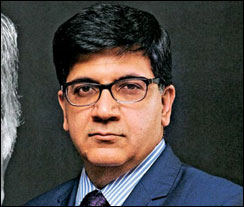
We have to prepare for the future.
What do you do to transform the business of OEMs?
We have recently acquired Cambric Corporation, a specialist organisation focusing on construction and heavy engineering with a special emphasis on Tier-3 and Tier-4 emission implementations. Cambric has worked with western companies, has around 350 engineers in Romania and also worked on different products in the construction space. Now, using our expertise in the automotive and aerospace world and combining it, we have done things like frugal engineering and we have applied that for benchmarking in the construction space in the last one-and-a-half years. Taking that beyond and building end-to-end propositions for next generation product development engineering in the construction and heavy engineering space, Cambric will help us develop further; we are already in talks with four companies towards that end.
What is the current market trend for construction equipment?
Reports estimate the industry to be currently in the range of $3.5 billion, and is slated to grow to about $20 billion by 2020, which is a huge growth. There are multiple enablers needed to make this happen. We have built a Special Interest Group under NASSCOM?s Engineering Chapter. It is about providing the right kind of advice on technology, innovation and engineering talent. In addition, the industry needs to build readiness by overcoming challenges such as forestry and land acquisition issues that need to be resolved, funding flow and others. So, financial institutions have to be willing to fund these companies, and policies on emission standards need to be clearer.
How do you view the Prime Minister?s intervention in the matter?
I think more needs to be done to move things quickly. Once that is done, then industry players need to take over and provide the additional enablers: better engineers, better training to engineers as well as operators. So we are helping with that as well as with engineering support that we can bring from around the globe. Moreover, emerging market product challenges are different and we have to be sensitive to the Indian needs as well as the right things to be done for successful products from India to the world market.
Is there a big difference between local and global innovation?
If you look at the experience we have had with the Nano, you will see that how it sells in India is one thing, and how it sells outside India, is another. We launched it in the Western world and you will not believe the kind of interest we got from construction companies.
We are now trying to bring our products to the developing world, to India and China and some others as well. Then again, India, China, the Middle East, South Africa and some of the ASEAN countries have the same problem: we have to de-content but keep our brand, we have to make it reliable, and all the safety and emission standards have to be met. We may have a different price point and different operating conditions but I think that is applicable across the globe.
Do you think that streamlining project implementation can help the infrastructure sector?
It is a bottleneck where the whole thing is stuck. We are missing an opportunity of 1-2 per cent on the GDP. If today we are growing at 4.5 per cent, we can easily grow at 5.5 or 6 per cent once infrastructure projects are cleared.
What is your role in skill development in the CE market?
I think there are many dimensions. Last September, we started an SIG in construction and heavy engineering, because we knew that the growth in this sector was going to be huge and there were a lot of people who were interested. A major focus area here is talent development. In association with ICEMA, we have made a matrix of who will initiate what and go with what; we have taken up this SIG to help with talent development on the engineering side. There again we are helping, working with various institutions. Today, there is a need for six lakh operators while only 50,000 are available. It is less than ten per cent so there is a huge demand for operator training. Similarly, on the engineering side, there are seven lakh engineers passing out every year, out of which, only 25 per cent are employable. If this market is growing at more than 20 per cent, we need to attract these engineers to this market; we have to make them aware that such a market exists and it is an exciting, growing market. We have launched the Foundation Skills in Integrated Product Development (FSIPD) programme, a generic elective course that 14-15 different colleges including NIITs, IITs and SRM are going to be providing as an elective.


 +91-22-24193000
+91-22-24193000 Subscriber@ASAPPinfoGlobal.com
Subscriber@ASAPPinfoGlobal.com